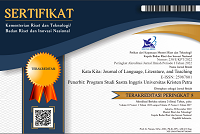Children’s Picture Book Series on Exploring Children’s Development of a Balanced Identity
DOI:
https://doi.org/10.9744/katakita.9.2.113-119Keywords:
Manajemen, perubahan perilaku pasar, usaha keluargaAbstract
This paper elaborates the project of creating picture-book stories for two to five years old of Indonesian children, which highlight the issue of identity development in children. Erik Erikson’s eight stages of psychosocial development will be the theoretical framework of this paper. In the first and second story, the main characters pass through the crisis of autonomy versus shame and doubt. They have strict and overprotective parents that caused them to doubt themselves. However, by believing in themselves and taking an action, they passed the crisis and developed a balanced identity. In the third, fourth, and fifth story, the main characters pass through the crisis of initiative versus guilt. They learn to be honest, to forgive, and to let go. Each action has its own risk, but by taking the initiative to do the right thing, they passed the crisis successfully and formed a balanced identity.
Keywords: children picture-books, children development, psychosocial development, autonomy vs shame and doubt, initiative vs guilt, balanced identity
References
Batra, S. (2013). The Psychosocial Development of Children: Implications for Education and Society — Erik Erikson in Context. Contemporary Education Dialogue, 10(2), 249–278. https://doi.org/10.1177/0973184913485014
Cherry, K. (2020, June 26). Understanding Erikson's Stages of Psychosocial Development. Verywell Mind. https://www.verywellmind.com/erik-eriksons-stages-of-psychosocial-development-2795740.
Erikson, E. H. (2014). Childhood and Society. Vintage Digital.
Hunt, P., & Bannister, R. S. G. (2014). International Companion Encyclopedia of Children's Literature. Google Books. Routledge. https://books.google.co.id/books?hl=en&lr=&id=t1RsBgAAQBAJ&oi=fnd&pg=PA418&dq=%22genre%22+%22animal+stories%22&ots=BP5kOVVB0J&sig=zqpz-BBJCu8P32KHUp5OuXvYtOw&redir_esc=y#v=onepage&q=%22genre%22%20%22animal%20stories%22&f=false.
Huntington, C. (2017). Early Childhood Development and the Law. Southern California Law Review, 90. https://ir.lawnet.fordham.edu/cgi/viewcontent.cgi?article=1876&context=faculty_scholarship.
Izzaty, R. E. (2018). Happiness in Early Childhood. Psychological Research and Intervention, 1(2). https://doi.org/10.21831/pri.v1i2.22024
Lenze, S. N., Pautsch, J., & Luby, J. (2010). Parent-Child Interaction Therapy Emotion Development: A Novel Treatment for Depression in Preschool Children. Depression and Anxiety, 28(2), 153–159. https://doi.org/10.1002/da.20770
Lerer, S. (2009). Ingenuity and Authority - Aesop’s Fables and Their Afterlives. In Children's Literature: A Reader's History, from Aesop to Harry Potter (pp. 35–56). essay, University of Chicago Press.
Lingard, L. T. (2016). The Publishing Industry in Indonesia. Publishing Research Quarterly, 32(1), 54–57. https://doi.org/10.1007/s12109-016-9446-7
Markowsky, J. K. (1975). Why Anthropomorphism in Children's Literature? Elementary English, 52. https://www.jstor.org/stable/41592646?seq=1.
McCabe, P. C., & Altamura, M. (2011). Empirically Valid Strategies to Improve Social and Emotional Competence of Preschool Children. Psychology in the Schools, 48(5), 513–540. https://doi.org/10.1002/pits.20570
McCormick, S. (1977). Should You Read Aloud to Your Children? Language Arts, 54. http://www.jstor.org/stable/41404495.
Miller, J. W., & McKenna, M. C. (2016). World Literacy. Research Gate. https://doi.org/10.4324/9781315693934
Ninsuwan, P. (2015). The Effectiveness of Teaching English by Using Reading Aloud Technique towards EFL Beginners. Procedia - Social and Behavioral Sciences, 197, 1835–1840. https://doi.org/10.1016/j.sbspro.2015.07.243
Room to Read. (2019). Why Indonesia? Room to Read. https://www.roomtoread.org/indonesia/.
Wibisono. (2018). RESUME SURVEI DAMPAK COVID-19. IKAPI. https://www.ikapi.org/riset/.
Downloads
Published
Issue
Section
License
Authors who publish with this journal agree to the following terms:- Authors retain copyright and grant the journal right of first publication with the work simultaneously licensed under a Creative Commons Attribution License that allows others to share the work with an acknowledgement of the work's authorship and initial publication in this journal.
- Authors are able to enter into separate, additional contractual arrangements for the non-exclusive distribution of the journal's published version of the work (e.g., post it to an institutional repository or publish it in a book), with an acknowledgement of its initial publication in this journal.
- Authors are permitted and encouraged to post their work online (e.g., in institutional repositories or on their website) prior to and during the submission process, as it can lead to productive exchanges, as well as earlier and greater citation of published work (See The Effect of Open Access).














